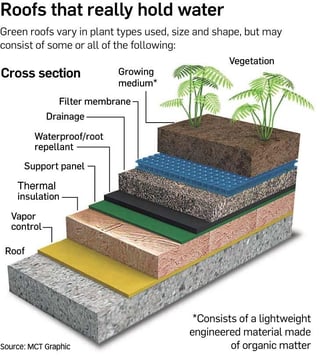Layers of a green roof:
Waterproof Membrane
A waterproof membrane is designed to protect the building components from the weather, over which the vegetative roof system is installed. Membranes are required for all roofs types. For this reason, the membrane should be removed from any cost-analysis comparisons when determining between different types of roof to install.
Leak Detection System
Leak detection systems help identify problem areas where water surpasses the membrane and could cause roof damage if left unattended. The electronic leak detection method enables the detection and location of any leak, even pin-hole-sized defects, but requires the installation of a fine grid of metal wire within the planted roof and waterproofing layers. See Roof Leak Prevention for more information.
Drainage Layer
Planted roof drainage layers carry the excess stormwater runoff to the roof drains, and eventually off the roof. A properly designed planted roof will not have water sitting on top of it – any stored water will reside in the growing medium and vegetation.
There are three main types of drainage layers used on planted roofs: simple geocomposite drain layers, reservoir sheets, and granular mineral medium.
- Granular medium is the best at slowing and delaying runoff.
- Reservoir sheets are designed to capture rainwater in indentations in their surface.
- Geocomposites, or multi-layered materials made from a combination of synthetic polymers, are adapted for planted roofs and designed to allow water to flow easily through the material, draining excess water away from a roof.
The type of drainage layer and the type of separation or moisture retention fabrics used in a roof will influence the roof’s performance.
Root-Resistant Layer
A membrane designed to provide protection to the underlying waterproofing membrane from root penetration and provide protection from microorganisms in the growth medium. Failure to use a root-barrier can cause structural damage to the waterproof membrane, and therefore can subsequently lead to demolition of the planted roof and the underlying waterproofing.
Growing Medium

- Size: Smaller particles have a higher surface area-to-mass ratio and smaller pores, both of which enhances the medium’s water retention capacity and capillarity, or its ability to absorb water through the capillary action that draws water into a particle.
- Type: As the proportion of organic matter in growth medium increases, so does its water retention capacity. However, too much organic material in a medium can cause it to shrink as the material decomposes. If the organic material contains high levels of nutrient salts, or various phosphorus and nitrogen compounds that have a fertilizing effect, it can even decrease the quality of runoff from the roof.
- Depth: The thicker the growth medium the more water the roof can absorb, at least up to a point. In general, a thicker roof can be expected to retain more water from an individual storm. A 4-inch roof can typically retain 1 to 1.5 inches of rain. This means that in the summer, when most storms produce less than 1 inch of precipitation, 90% of storms are largely retained. However, benefits do not depend exclusively on depth, and thinner extensive planted roofs yield the greatest benefit-to-cost ratio.




